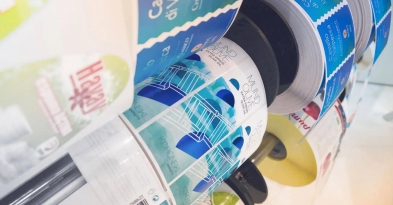
Metallic labels are the most used in the world, especially in packaging and in the food and non-food industry.
Compared to other types, metallic labels allow the composition of packaging with printing, which helps in the identification and aesthetic differentiation of the product, since metallic labels are the perfect way to differentiate a product and make it stand out on the shelves of the points of sales regardless of the sector of activity in which it operates.
In this article we will share with you the different types of uses for metallized labels that may help you add value to your products.
Cleaning products labels

Along with the type of packaging, the design and material of which a label is made have a great influence on the affirmation of a product’s positioning and on the consumer’s perception of it and, subsequently, on their purchasing behavior.
Studies on consumer behavior suggest that there is a correlation between the use of metallic elements on the labels of this type of products and the consumer’s perception of extreme cleanliness, since metallic elements seem to invoke cleanliness, shine and disinfection.
In addition, metallized materials also help draw the buyer’s attention to warnings or special ingredients in some chemicals and cleaning products.
It is important to realize that it is not only in the food industry that labels have a decisive role in the marketing and communication of products. This importance is also felt in the non-food industry, as it is a highly competitive and segmented industry. On the shelves of the points of sale, we are confronted with a wide variety of brands and products that are fighting for our attention and preference.
Cosmetic products labels

If there is an industry in which image plays a decisive role in the success or failure of a product or a brand, it is clearly the cosmetics industry. Highly competitive and segmented, there is a wide variety of brands in this industry, many of them with a lot of notoriety, status and recognition.
Once again, metallic labels are a great way to almost instantly leverage a cosmetic product. The metallic look appeals to values such as status, quality, luxury and sophistication that normally meet the values, attitudes and perceptions of the target audience of this type of product.
The “glossy look” of the metallic material can also be used to give life to sparkling products such as serums, highlighters, shadows, among many others.
If you do some benchmarking, you will see that many of the major cosmetic brands on the market choose to use metallized labels on their products as a way of affirming and consolidating their positioning and as an instrument of buyer seduction.
Alcoholic beverage labels

This is also a highly competitive market. Large multinationals dominate this “aggressive” ecosystem with very dynamic pipelines whose practical consequence is the shelves of points of sale offering consumers a wide range of alternatives.
In this industry, packaging and labeling also play a very important role and it is not uncommon for consumer attention and subsequent product purchase to be due to the seductive ability of the label and packaging.
With the number of alcoholic beverage brands increasing every year, it is important (especially for new brands) to bet on packaging and labels that differentiate themselves from the competition, which, as already mentioned, is particularly aggressive in this type of market. Here again, metallic labels are often the perfect solution. The brightness and reflection of this type of label makes the product instantly more attractive to the consumer, not least because this type of material gives the product extra personality and can be used to illustrate unique flavors with a fun, metallic touch.
Food supplement labels

In the last decade, the food supplement industry has shown absolutely stunning growth rates. The change in people’s lifestyle, the cult of the body and preventive care with physical and mental health, created a huge demand for this type of product. This exponential increase in demand not only caused many new brands to appear on the market, but also motivated existing ones to launch new products in order to strengthen their portfolio and meet the new needs of the public.
With regard to marketing, the food supplement industry increasingly favors the attractiveness of labels as there are studies that support the theory that consumers react very positively to this type of stimulus. Colors, finishes, appealing and distinctive fonts, different materials, etc.
In fact, food supplements such as vitamins, omega 3, amino acids, protein, astaxanthin and probiotics (among many others) have always been a popular choice for metallic labels, precisely because brands understand that this type of material adds value to products by highlighting and positioning them in a different and more impactful way in the consumer’s mind and in the crowded shelves of points of sale.
Metallic labels for award-winning products

Metallic labels or tags are also often used to highlight an award or accolade that a particular product has won for its quality.
This is a very impactful, effective and inexpensive way of giving visibility to a recognition that the product has acquired on its own merit. It would not make sense to miss the opportunity to highlight a strength that will most likely be relevant to the consumer and could even lead him to decide to buy a certain product over others that do not show the same recognition.
If you have an award-winning product (or range of products), be sure to celebrate and emphasize this achievement by placing a metallic label on the product.
Usually the most commonly used colors are silver and/or gold but in these things there are no absolute truths. The most important thing is to highlight the recognition that your product has earned.
With this article, we hope, in some way, to have helped to understand the most frequent uses of metallic labels that, as we have seen, can leverage a product’s image, its impact on the shelf, its differentiation from competing products and, above all, the determining influence they can have on consumer perception and behavior




